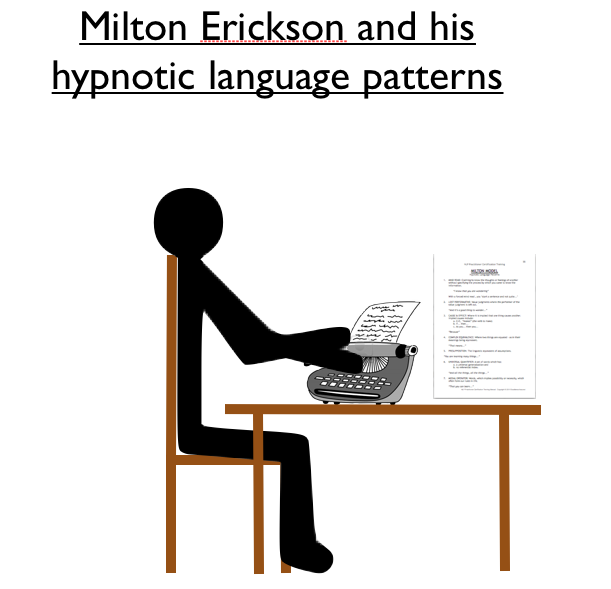The NLP Milton Model is a set of language patterns used to help people to make desirable changes and solve difficult problems. It is also useful for inducing trance or an altered state of consciousness to access our all powerful unconscious resources.
Otherwise described as ‘metaphors for artfully vague suggestions.’
‘Milton’ is derived from the Hypnotherapist Milton Erickson and we explain in detail how to use these NLP Language patterns in our NLP Training Courses.

The patterns are all part of our every day language, NLP provides us with titles for the language patterns that enable us to identify them and therefore once learnt we can use them intentionally to assist us in achieving our desired results from our communication with others.
Milton Model statements can be very persuasive and therefore NLP encourages you to use them with ecology and care for others.
Unless you are planning to train NLP, you do not need to memorise the titles of the patterns. Just to understand what they are, how they are used and to be able to create your own examples will be sufficient for you to use them effectively.
- Mind Read
- Lost Performative
- Cause and Effect
- Complex Equivalence
- Presupposition
- Universal Quantifier
- Modal Operator
- Nominalisation
- Unspecified Verb
- Tag Question
- Lack of Referential Index
- Comparative Deletion
- Pace Current Experience
- Double Bind
- Conversational Postulate
- Extended Quotes
- Selectional Restriction Violation
- Ambiguity
- Utilisation
Did you know that you can certify as a Practitioner and Master Practitioner of NLP in our virtual training room using our NLP online training e-Learning facilities.
Example Milton model language patterns;
- As I am sitting here, in this chair, in my living room, typing this self reflection, now (1. pace current experience) I am gaining more and more knowledge and learning (2. nominalisation) with regard to the ways in which I can access my own unconscious mind… aren’t I? (3. tag question). I know now no nosey person knows no boundaries (4. phonological ambiguity) when wondering what I am doing the course is fun (5. punctuation ambiguity). Now and then (6. comparative deletion) as I wonder about all language forms (7. universal quantifier) and ask, do you understand what I mean…….or do you not? (8. conversational postulate). And you will eventually (9. unspecified verb),either now or later (10. double bind).
- The wonderful thing about this insightful training (1. nominalisation) is that, sooner or later (2. comparative deletion) it enables my growth, and the ability to help myself …and do other things too. (3. lack of referential index). And as I am thinking about it (4. pace current experience), I do (5. unspecified verb)…now or later (6. double bind). I enjoy watching the videos are really very good (7. punctuation ambiguity), and just as grass can whisper (8. selectional restriction violation) I can participate in the exercises, and write them right with the right intentions (9. phonological ambiguity)….don’t I? (10. tag question).
- If you think about it, then you will realise (1. cause & effect) all people (2. universal quantifier) will reveal (3. presupposition) the way in which they are actually thinking, like you are now(4. pace current experience), by observing the directions in which their eyes move around a lot whilst people talk! (5. punctuation ambiguity). It’s new, I never knew that before, but now I do know it now, no? (6. phonological ambiguity) Isn’t that wonderful!(7. tag question). To realise that you can learn these things (8. modal operator) at my age is good. But then, I know that you where thinking about that now….(9. mind read). I will learn more about this phenomenon. In fact I can study it further right now…or maybe later…but I will…eventually(10. double bind).
- Milton Erickson used trance on all of the people that he met (1. universal quantifier), for the good of them and posthumously the good of mankind (2. presupposition) through his recorded teachings. As I ponder this now (3. pace current experience) I realise that is wonderful….is it not? (4. tag question). To be able to access his work through this work works in all walks of work, or it would work…if only they knew (5. phonetic ambiguity). Indeed, that reminds me…when I was young I used to work in a newspaper print shop I knew a man who taught me a lot of things…like how carry out maintenance on the machines, he also knew how to play the accordion. It is a strange but expansive instrument. My grandfather also played the accordion…and he was also a talented woodworker. He used to make fabulous furniture and turnings on his lathe in his shed; sheds are so useful for many things to humble, working class people…like he was. But I digress…..(6. extended quote). Wood is a living material, even after it has been felled. Some people believe that plants and trees have feelings (7. selectional restriction violation)….if so, can you imagine the pain inflicted upon a tree as it is chopped down? Did you know that…..I was eventually going to discuss the feelings of trees? (8. conversational postulate). Perhaps it is prudent, after all trees that have been transformed into paper by men of old (9. scope ambiguity) from a better vanished time, supported the written word, and therefore preserved history and all types of knowledge. Now you know, now about what I have said… (10. lack of referential index). The meaning of life is the thing that gives meaning to your life….
What are meta model responses? Read about the NLP Meta Model
